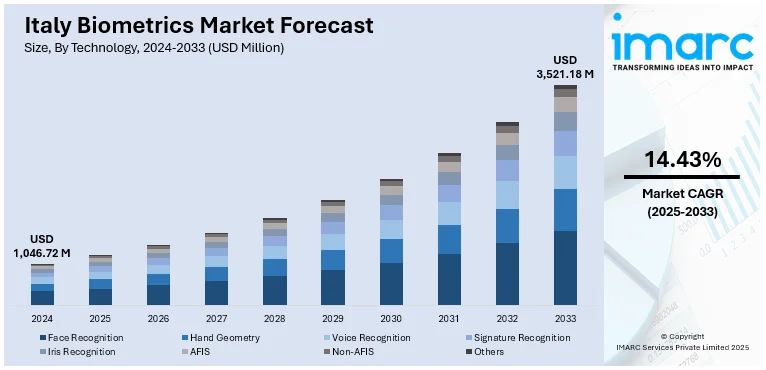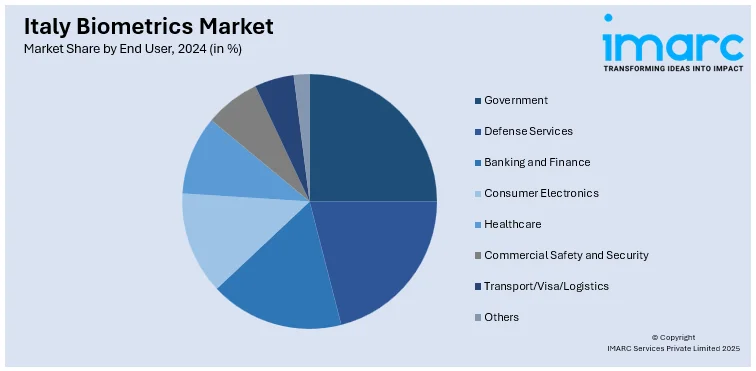
Italy Biometrics Market Size, Share, Trends and Forecast by Technology, Functionality, Component, Authentication, End User, and Region, 2025-2033
Italy Biometrics Market Overview:
The Italy biometrics market size reached USD 1,046.72 Million in 2024. Looking forward, the market is projected to reach USD 3,521.18 Million by 2033, exhibiting a growth rate (CAGR) of 14.43% during 2025-2033. The market is expanding steadily, driven by rising demand for secure identification in banking, government, and corporate sectors. Increasing use of facial recognition, fingerprint scanning, and iris authentication in public services and digital platforms is enhancing efficiency and safety. Growing adoption of biometrics in healthcare, transportation, and smart city projects is further strengthening the overall Italy biometrics market share.
|
Report Attribute
|
Key Statistics
|
|---|---|
|
Base Year
|
2024
|
|
Forecast Years
|
2025-2033
|
|
Historical Years
|
2019-2024
|
| Market Size in 2024 | USD 1,046.72 Million |
| Market Forecast in 2033 | USD 3,521.18 Million |
| Market Growth Rate 2025-2033 | 14.43% |
Italy Biometrics Market Trends:
Smart City Initiatives Enhancing Biometrics Adoption
In Italy smart city projects are facilitating the use of biometric technologies particularly within surveillance systems, access control, and public safety initiatives. As urban infrastructure evolves authorities are incorporating biometric solutions to improve monitoring capabilities and bolster city security. Biometric surveillance systems allow for real-time identification aiding in crime deterrence and emergency response. Additionally, access control mechanisms in public spaces, transportation terminals, and government facilities utilize biometric verification to enhance security and optimize operations. These implementations align with Italy’s objective of fostering interconnected technology-oriented urban settings. By integrating biometrics into smart city frameworks, the government and local administrations are promoting safer and more efficient communities. This shift builds public confidence and heightens demand significantly impacting the growth of the biometrics market in Italy.

To get more information on this market, Request Sample
Multi-Modal Authentication Strengthening Security
The trend of multi-modal authentication is becoming increasingly significant in Italy's biometrics landscape, as it meets the demand for enhanced accuracy and dependability in identity confirmation. Rather than depending on a single biometric approach, organizations are employing a combination of facial recognition, fingerprint analysis, and iris scanning to minimize errors and heighten security. This comprehensive strategy improves fraud prevention and is especially vital in areas such as finance, healthcare, and governmental services. Multi-modal systems also promote accessibility by accommodating users whose biometric information may not always be captured effectively by one method. With the rising focus on stringent data protection and regulatory compliance, both public and private sectors are moving toward these sophisticated solutions. By providing improved accuracy and stronger defenses against attacks, multi-modal authentication is becoming a key factor driving the growth of the biometrics market in Italy.
Expansion in Public Services Driving Biometrics Adoption
The expansion of biometrics in Italy's public services is a major factor driving adoption, playing a significant role in Italy biometrics market growth. Government entities are increasingly utilizing biometric technologies for national identification initiatives, e-passports, and border security to improve identity verification processes and bolster public safety. For instance, in January 2025, Italy announced its plans to enforce mandatory fingerprint collection for Schengen (type C) and national entry (type D) visa applicants. Applicants must submit their applications in person, with biometric data stored for 59 months. These technologies aid in streamlining administrative tasks, minimizing identity fraud risks, and enhancing the efficiency of immigration and security systems. The use of fingerprint, facial, and iris recognition technologies guarantees higher accuracy and reliability in verifying individuals and travelers. Moreover, as Italy upgrades its public service infrastructure, biometrics is becoming increasingly vital in promoting digital governance and secure citizen participation. By integrating these solutions into national policies, the government is fostering a reliable environment for both domestic and international engagements, which in turn propels the continued growth of the Italy biometrics market.
Italy Biometrics Market Segmentation:
IMARC Group provides an analysis of the key trends in each segment of the market, along with forecasts at the country and regional levels for 2025-2033. Our report has categorized the market based on technology, functionality, component, authentication, and end user.
Technology Insights:
- Face Recognition
- Hand Geometry
- Voice Recognition
- Signature Recognition
- Iris Recognition
- AFIS
- Non-AFIS
- Others
The report has provided a detailed breakup and analysis of the market based on technology. This includes face recognition, hand geometry, voice recognition, signature recognition, iris recognition, AFIS, non-AFIS, and others.
Functionality Insights:
- Contact
- Non-contact
- Combined
A detailed breakup and analysis of the market based on the functionality have also been provided in the report. This includes contact, non-contact, and combined.
Component Insights:
- Hardware
- Software
The report has provided a detailed breakup and analysis of the market based on the component. This includes hardware and software.
Authentication Insights:
- Single-Factor Authentication
- Multifactor Authentication
A detailed breakup and analysis of the market based on the authentication has also been provided in the report. This includes single-factor authentication and multifactor authentication.
End User Insights:

- Government
- Defense Services
- Banking and Finance
- Consumer Electronics
- Healthcare
- Commercial Safety and Security
- Transport/Visa/Logistics
- Others
A detailed breakup and analysis of the market based on the end user has also been provided in the report. This includes government, defense services, banking and finance, consumer electronics, healthcare, commercial safety and security, transport/visa/logistics, and others.
Regional Insights:
- Northwest
- Northeast
- Central
- South
- Others
The report has also provided a comprehensive analysis of all the major regional markets, which include Northwest, Northeast, Central, South, and others.
Competitive Landscape:
The market research report has also provided a comprehensive analysis of the competitive landscape. Competitive analysis such as market structure, key player positioning, top winning strategies, competitive dashboard, and company evaluation quadrant has been covered in the report. Also, detailed profiles of all major companies have been provided.
Italy Biometrics Market News:
- In July 2025, Italy announced its plans to digitize civil status records through the National Archive of Civil Status (ANSC), enhancing service efficiency. The national digital services app “IO” now offers offline access to documents, using biometric authentication. With nearly 90 million digital identities issued, Italy progresses toward a unified digital wallet and improved public services.
- In June 2024, Fingerprints partnered with Italy's WiBioCard to deliver advanced biometric smart card solutions for global access. Integrating Fingerprint's biometrics enhances security, enabling password-free logins and protecting sensitive data. This collaboration aims to promote secure, convenient authentication across various sectors, enhancing user experience while ensuring privacy compliance.
Italy Biometrics Market Report Coverage:
| Report Features | Details |
|---|---|
| Base Year of the Analysis | 2024 |
| Historical Period | 2019-2024 |
| Forecast Period | 2025-2033 |
| Units | Million USD |
| Scope of the Report |
Exploration of Historical Trends and Market Outlook, Industry Catalysts and Challenges, Segment-Wise Historical and Future Market Assessment:
|
| Technologies Covered | Face Recognition, Hand Geometry, Voice Recognition, Signature Recognition, Iris Recognition, AFIS, Non-AFIS, Others |
| Functionalities Covered | Contact, Non-contact, Combined |
| Components Covered | Hardware, Software |
| Authentications Covered | Single-Factor Authentication, Multifactor Authentication |
| End User Covered | Government, Defense Services, Banking and Finance, Consumer Electronics, Healthcare, Commercial Safety and Security, Transport/Visa/Logistics, Others |
| Regions Covered | Northwest, Northeast, Central, South, Others |
| Customization Scope | 10% Free Customization |
| Post-Sale Analyst Support | 10-12 Weeks |
| Delivery Format | PDF and Excel through Email (We can also provide the editable version of the report in PPT/Word format on special request) |
Key Questions Answered in This Report:
- How has the Italy biometrics market performed so far and how will it perform in the coming years?
- What is the breakup of the Italy biometrics market on the basis of technology?
- What is the breakup of the Italy biometrics market on the basis of functionality?
- What is the breakup of the Italy biometrics market on the basis of component?
- What is the breakup of the Italy biometrics market on the basis of authentication?
- What is the breakup of the Italy biometrics market on the basis of end user?
- What is the breakup of the Italy biometrics market on the basis of region?
- What are the various stages in the value chain of the Italy biometrics market?
- What are the key driving factors and challenges in the Italy biometrics market?
- What is the structure of the Italy biometrics market and who are the key players?
- What is the degree of competition in the Italy biometrics market?
Key Benefits for Stakeholders:
- IMARC’s industry report offers a comprehensive quantitative analysis of various market segments, historical and current market trends, market forecasts, and dynamics of the Italy biometrics market from 2019-2033.
- The research report provides the latest information on the market drivers, challenges, and opportunities in the Italy biometrics market.
- Porter's five forces analysis assist stakeholders in assessing the impact of new entrants, competitive rivalry, supplier power, buyer power, and the threat of substitution. It helps stakeholders to analyze the level of competition within the Italy biometrics industry and its attractiveness.
- Competitive landscape allows stakeholders to understand their competitive environment and provides an insight into the current positions of key players in the market.
Need more help?
- Speak to our experienced analysts for insights on the current market scenarios.
- Include additional segments and countries to customize the report as per your requirement.
- Gain an unparalleled competitive advantage in your domain by understanding how to utilize the report and positively impacting your operations and revenue.
- For further assistance, please connect with our analysts.
 Request Customization
Request Customization
 Speak to an Analyst
Speak to an Analyst
 Request Brochure
Request Brochure
 Inquire Before Buying
Inquire Before Buying




.webp)




.webp)












